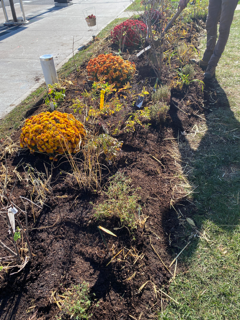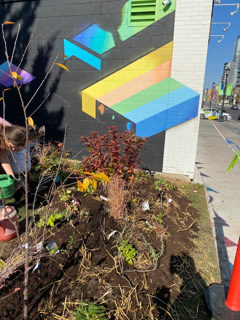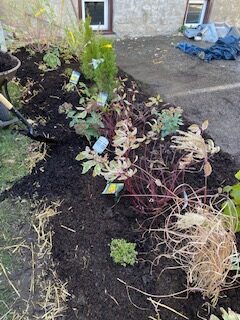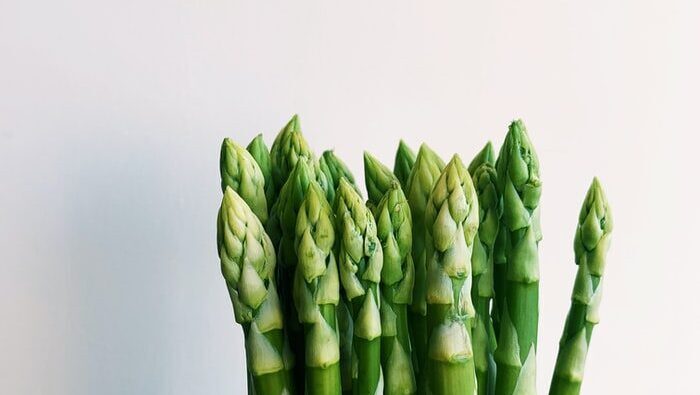By: Cristy Argueta
Published: October 31, 2022
On Saturday, October 22nd, at 99 King Street North, Uptown Waterloo an urban food forest garden was built by the community for the community under the excellent leadership of Nicola Jane Thomas, founder of Grand River Food Forestry (GRFF). A food forest is a planting of food-bearing plants, including fruit trees, berries, herbs, and medicinal and pollinator perennials towards annual food provision, environmental stewardship and climate resilience and community building (GRFF, n.d.).
The designated location is tucked between the longstanding Old Goat Books store and an in-progress mural with colorful geometric shapes connected with leaves and vines that complements the newly built food forest. This event was made possible by the energetic do-gooder, Samantha Kristoferson and her partner Emilio Jose Garcia Rodriguez, founders of the KW Professional Organizers (KWPO), who organized the grant to authorize the food forest. The food hedge was created along the sidewalk of King Street, immediately capturing interest of community members passing by. An additional garden section was established towards the back of the property. This space is envisioned to be a place where all members of the community can access fresh, healthy food. Nicola expressed a vision of a community space, perhaps by hanging hammocks as a place of rest and gathering. It seems only fitting that such a beautiful space built by the community be created for the community.
Nicola Thomas
Nicola Thomas, founder of Grand River Food Forestry, is an esteemed permaculture expert and award-winning Ecological Landscape Designer. Her presence and leadership were profoundly felt at this event. This was her first and last project of the year, as she was otherwise preoccupied on the “Sankofa 100 to Freedom Tour” 2022 celebrating and bringing awareness to the African Diaspora Women of Ontario. More information can be found on Grand River Food Forestry or in Nicola’s new book, BLM COLLECTION: Soul To Soil.

Indigenous Presence
Before the planting took place, Sally Owens, an elder from the Chippewa Potawatomi family, and her granddaughter Aryawna Isaac, who does work with White Owl Native Ancestry Association, gave thanks and acknowledgement to Creator. Sally’s message urged inclusion of children and that “kids were never too young to learn.” Even as they play, they are learning whether they realize it or not. That is exactly what the children whose parents joined the event did, even going as far as digging holes with their miniature shovels. Sally and Aryawna then smudged and gave the volunteers an opportunity to participate if they wished, which most did, and smudged the plants as well. Throughout the event, their presence was known, especially when they performed a drum song.
Building the Food Forest — Lasagna/ No Till Gardening
Nicola guided volunteers through a practice called “lasagna” or “no till” gardening. She had already arranged the plants, which consisted of:
- Daylily
- Cedar
- Hostas
- Dogwood
- Thyme
- Vidal grape
- Hakuro nishiki willow
- Autumn joy sedum
- Dwarf russian sage
- Sour cherry trees
- Royal prune plum
- Currents
- Red gooseberry
- Bear berry
- Bunch berry
- Goji berry superfruit firecracker
- Black chokeberry
- Titan sea berry (male and female)
- Grasses
- Red prince weigela
- Japanese spruge
- Black lace
- Prairie smoke
- Cone flower
- Wild rose
- And more
Nicola instructed us to dig holes and place the potted plants in it. With the excess soil, we built up a barrier of what would be the garden bed and spread it within. Then, we soaked cardboard and ripped pieces to lay over top of the soil. The cardboard serves to prevent weeds and sod from surfacing while also providing food and bedding for worms. Another layer of soil and straw was spread on top of the cardboard. Finally, the planting began. We removed the pots from the plants and planted them in the raised bed and mulched the beds. The garden was given a thorough watering at the end.
Lasagna land management practice was ideal for this project because it
- Requires little maintenance
- Avoids tilling, which damages soil structure, insect habitats and beneficial microbes contributing to soil health
- Provides food and bedding for the worms that turn the soil
- Retains water
- Serves as a windblock, shade, and prevents rain erosion
- Suppresses weeds and encourages mycelium necessary for soil health



Our Food Forest
This food forest will serve to benefit the environment and community alike. Food forests are known to naturalize landscapes, create habitat, attract pollinators, and build climate resilience. You could immediately see the effects of the forest, as ladybugs, bees, and birds were already attracted to the nutritious perennials. Additionally, this food forest builds community, which was evident throughout the event amongst the leaders and volunteers. Following this community building event, we hope for the forest to foster engagement with the land and improve our relationship with the ecosystem amongst our community.
References
Grand River Food Forestry. (n.d.). Permaculture Services – Regenerative & Restorative Land Practices. Retrieved from https://www.grandriverfoodforestry.com/projects.
ClimateActionWR. (2021). Creating Food Forests in Waterloo Region. Retrieved from https://climateactionwr.ca/events/creating-food-forests-in-waterloo-region/.

